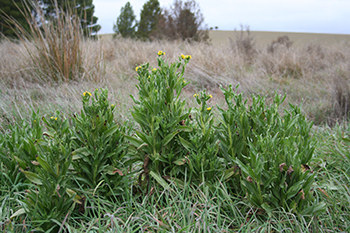Pest plant - Yellow burrweed
- Fact sheet
- August 2015

Yellow burrweed (Amsinckia species) is an annual herb that is highly competitive with cereal crops and can contaminate grain and wool.
Description
- erect annual herb, 20-70cm high
- stems are branched and covered with short stiff hairs
- leaves are to 20cm long also with tiny hairs
- leaves at ground level form a rosette, smaller leaves are arranged alternately along the stem
- flowers are bright yellow with five petals fused into a trumpet shaped tube 5mm long
- flowers are grouped along one side of a curved spike, to 15cm long and curled over on itself at the tip
- fruit is a group of 4 seeds surrounded by a bristly green husk
- ripe seeds are brown to black, ridged and roughly pyramid-shaped
- has a stout taproot with many lateral roots.
Why is it a problem?
- can drastically reduce crop yield
- seeds contaminate grain
- bristly fragments of the plant cause vegetable fault in wool
- may be poisonous to stock as it contains alkaloids.
Distribution
- Eyre Peninsula – isolated infestations
- Northern agricultural districts and Yorke Peninsula – scattered patches, more common in southern area
- Murray Mallee – isolated to widespread
- South East – widespread in upper south east, isolated in lower south east
- Central region – one small infestation, otherwise isolated plants.
Ecology
- not restricted by soil type but favours disturbed areas
- germinates in large numbers after autumn
- seedlings develop into a rosette during winter
- growth is rapid in spring, flowers appear in August and continues for two months
- flowers emerge progressively from the base of the spike through to the tip resulting in progressive seed production – ripe seeds fall while new flowers are opening at the tip of the spike
- plants die at the beginning of summer.
How it spreads
- reproduces only by seed – spread by stock and other animals, by machinery and in produce.